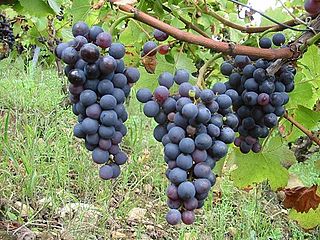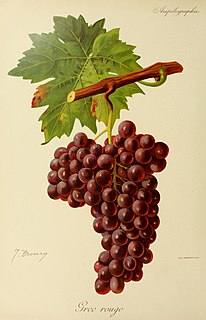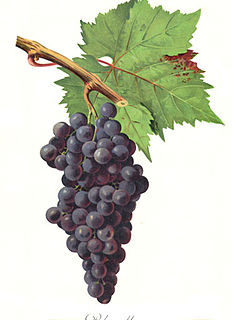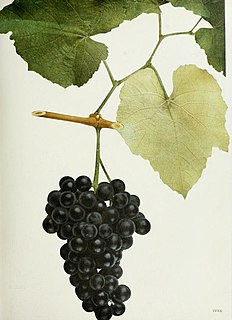
Merlot is a dark blue–colored wine grape variety, that is used as both a blending grape and for varietal wines. The name Merlot is thought to be a diminutive of merle, the French name for the blackbird, probably a reference to the color of the grape. Its softness and "fleshiness", combined with its earlier ripening, makes Merlot a popular grape for blending with the sterner, later-ripening Cabernet Sauvignon, which tends to be higher in tannin.

Malbec is a purple grape variety used in making red wine. The grapes tend to have an inky dark color and robust tannins, and are known as one of the six grapes allowed in the blend of red Bordeaux wine. In France, plantations of Malbec are now found primarily in Cahors in South West France, though the grape is grown worldwide. It is increasingly celebrated as an Argentine varietal.

Carignan is a red grape variety of Spanish origin that is more commonly found in French wine but is widely planted throughout the western Mediterranean and around the globe. Along with Aramon, it was considered one of the main grapes responsible for France's wine lake and was a substantial producer in jug wine production in California's Central Valley but in recent years, it has been reborn as a flagship wine for many cellars in the south of France as well as in Catalonia.

Colombard is a white French wine grape variety that is the offspring of Chenin blanc and Gouais blanc. This makes the grape the sibling of the Armagnac Meslier-Saint-François and the nearly extinct Cognac grape Balzac blanc.

Mauzac or Mauzac blanc a white variety of grape used for wine, of the species Vitis vinifera. It is mainly grown in the Gaillac and Limoux regions in the southwest of France. Total French plantations of Mauzac stood at 3,200 hectares in the year 2000.

Petit Verdot is a variety of red wine grape, principally used in classic Bordeaux blends. It ripens much later than the other varieties in Bordeaux, often too late, so it fell out of favour in its home region. When it does ripen it adds tannin, colour and flavour, in small amounts, to the blend. Petit verdot has attracted attention among winemakers in the New World, where it ripens more reliably and has been made into single varietal wine. It is also useful in 'stiffening' the mid palate of Cabernet Sauvignon blends.

Trousseau or Trousseau Noir, also known as Bastardo and Merenzao, is an old variety of red wine grape originating in eastern France. It is grown in small amounts in many parts of Western Europe; the largest plantations are today found in Portugal, where most famously it is used in port wine. It makes deep cherry red wines with high alcohol and high, sour candy acidity, and flavours of red berry fruits, often complemented - depending on production - by a jerky nose and an organic, mossy minerality.

Aligoté is a white grape used to make dry white wines, especially in the Burgundy region of France where it was first recorded in the 18th century. Since it is tolerant to cold, this variety is also cultivated in Eastern European countries. In 2004, it was the 22nd most planted vine variety in the world at 45,000 hectares.

Poulsard is a red French wine grape variety from the Jura wine region. The name Ploussard is used mainly around the town of Pupillin but can appear on wine labels throughout Jura as an authorized synonyms. While technically a dark-skinned noir grape, the skins of Poulsard are very thin with low amounts of color -phenols and produces very pale colored red wines, even with extended maceration and can be used to produce white wines. Because of this, Poulsard is often blended with other red-skin varieties or used to produce lightly colored rosé wines. Additionally the grape is used to make blanc de noir white wines and sparkling cremants.

Barbaroux is a pink-skinned French wine grape variety grown in southeastern France. It is a permitted variety in the appellation d'origine contrôlée wine of Cassis in Provence as well as in the Ajaccio region of Corsica. While it is sometimes known under the synonym "Barbarossa", DNA profiling has shown the Barbaroux grown in Provence is distinct from the Barbarossa vines grown in Liguria and Piedmont and is likely unrelated to all Italian Barbaross vines. There is also debate among ampelographers about whether the Barbaroux vines in Provence and Corsica are the same grape or separate Vitis vinifera varieties.
Tressot or Tressot noir is a variety of dark-skinned wine grape. Tressot has historically been grown in Burgundy but it is now almost extinct. Some small plantations still remain in the Chablis district of Burgundy.
Tibouren or Rossese di Dolceacqua is a red French wine grape variety that is primarily grown in Provence and Liguria but originated in Greece and possibly even the Middle East. Intensely aromatic, with an earthy bouquet that wine expert Jancis Robinson describes as garrigue, Tibouren is often used in the production of rosés.

Négrette is a dark red wine grape grown primarily in South West France in the region between Albi and Toulouse.
Abouriou is a red French wine grape variety grown primarily in Southwest France and, in small quantities, California. It is a blending grape that, along with Malbec, Cabernet Sauvignon, Syrah, Fer, Cabernet Franc, and Merlot, is used to make the Appellation d'origine contrôlée (AOC) wine of Côtes du Marmandais. Abouriou can also be made into a varietal, as it is used in some vin de pays wines. The grape is known for its low acidity and high tannin content.
Villard grapes are French wine hybrid grape created by French horticulturist Bertille Seyve and his father-in-law Victor Villard. They include the dark skin Villard noir and the white-wine variety Villard blanc with both being members of the Seyve-Villard grape family. Villard noir is a cross of two other French hybrids, Siebel 6905 and Seibel 7053 created by physician and plant breeder Albert Seibel. Like Villard noir, Villard blanc was produced as a crossing of two Seibel grapes, in this case, Le Subereux and Seibel 6468.

Ondenc is a white French wine grape found predominantly in the Gaillac region of southwest France. In the 19th century, it was a popular planting in Bordeaux but fell out of favor following the phylloxera epidemic due to poor yields and sensitivity to grape disease, though is still one of the seven white varieties permitted in Bordeaux. Prior to falling out of favor, vine cuttings were brought from Bordeaux to Australia where the grapes became known under the synonyms of Irvine's White in Victoria and Sercial in South Australia. The Australian grapes weren't identified as Ondenc till 1976 when French ampelographer Paul Truel identified the vine while visiting Australia. Today, the grape is nearly extinct in Australia except for a small amount of plantings in Victoria used in sparkling wine production.

Calitor or Calitor noir is a red French wine grape variety. It was previously widely cultivated in southern France, in particular in Provence, but is now very rare, almost extinct. Historically used as mainly a blending variety, Calitor gives high yields and produces a light-bodied and lightly colored wine. When grown on hillside sites, it can give a wine of character.
Merlot blanc is a white French wine grape variety that came from a natural crossing of the Bordeaux wine grape Merlot and the Cognac grape Folle blanche. The grape is distinct from Merlot gris which is a pink-skinned color mutation of the red wine grape Merlot and is sometimes used in vin gris and rosé wines. Plantings of Merlot blanc were first discovered in 1891 but cuttings of the vine have not been widely propagated and the variety is very rare. It is not used to make the sweet White Zinfandel-style wine White Merlot that is made by some California wine producers. Those wines are made from a saignee of red Merlot wine.

Ives noir is a red hybrid grape variety that is grown throughout the United States. Named after its propagator, Connecticut wine grower Henry Ives, the grape's pedigree and exact origin are unclear. After Prohibition in the United States, Ives was a popular grape used in the production of sweet port-style wines but saw its plantings steadily decrease throughout the 20th century as the vine's susceptibility to air pollution took its toll.
Canari noir is a red French wine grape variety that has been historically grown in the Ariège department in the foothills of the French Pyrénées. However DNA profiling in 2001 showed that plantings of a grape called Gamay Luverdon growing in the Italian wine region of Piedmont were in fact plantings of Canari noir. Across the Pyrénées in Spain, the grape variety known as Batista was also found to be identical to Canari noir. Like Pinot noir and Grenache, Canari noir has color mutations known as Canari blanc and Canari gris.















